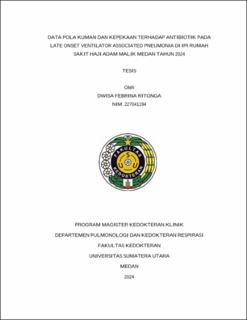Data Pola Kuman dan Kepekaan terhadap Antibiotik pada Late Onset Ventilator Associated Pneumonia di IPI Rumah Sakit Haji Adam Malik Medan Tahun 2024
Data on Germs Patterns and Sensitivity to Antibiotics in Late Onset Ventilator Associated Pneumonia at ICU Haji Adam Malik Hospital Medan 2024

Date
2024Author
Ritonga, Dwisa Febrina
Advisor(s)
Syarani, Fajrinur
Bihar, Syamsul
Ashar, Taufik
Metadata
Show full item recordAbstract
Background : Ventilator-associated pneumonia (VAP) is a lung infection that occurs in patients using mechanical ventilators for more than 48 hours, with late-onset VAP posing a high risk of multidrug-resistant (MDR) pathogens. Data on bacterial patterns and antibiotic sensitivity are crucial for empirical treatment and resistance control.
Methods: This study was a cross-sectional study involving 76 samples conducted at Haji Adam Malik General Hospital, Medan, in 2024. Demographic data, ventilator usage duration, length of ICU stay, and bacterial culture results were obtained from medical records. Antibiotic sensitivity testing was performed to determine resistance patterns.
Results: A total of 75 patients were diagnosed with late-onset VAP, with the majority aged >50 years (63.2%) and male (57.9%). The primary causative bacteria were Acinetobacter baumannii (44.7%) and Pseudomonas aeruginosa (15.8%). Sensitivity testing revealed high resistance to third- and fourth-generation cephalosporins, while colistin and polymyxin B remained effective. Key risk factors included the duration of ventilator use and length of ICU stay.
Conclusion: Acinetobacter baumannii is the dominant pathogen in late-onset VAP with high antibiotic resistance. Regular monitoring of bacterial patterns and antibiotic sensitivity is needed for more effective treatment and resistance prevention.
